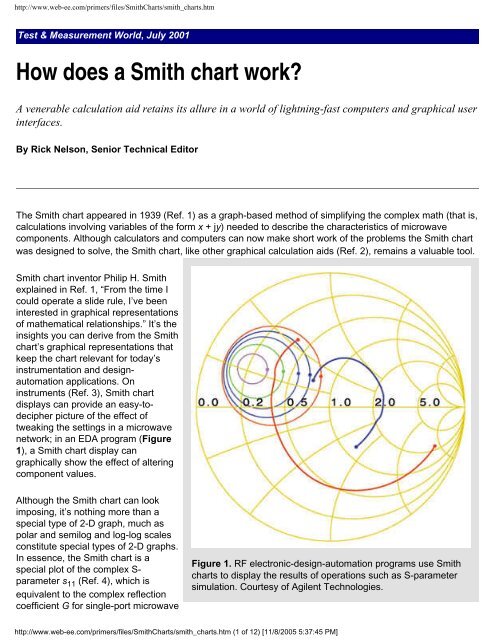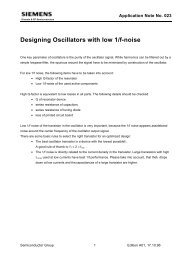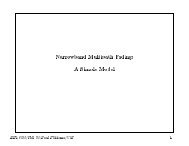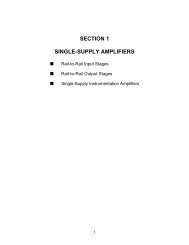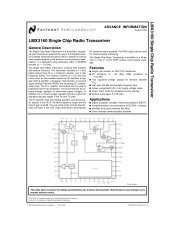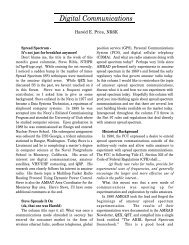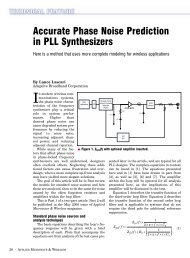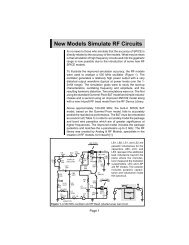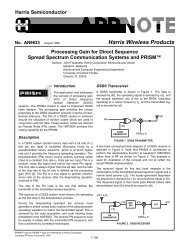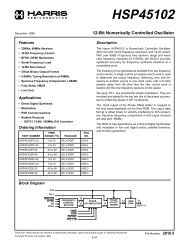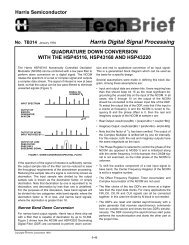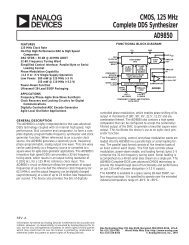"How does a Smith chart work?" by Rick Nelson, Senior Technical ...
"How does a Smith chart work?" by Rick Nelson, Senior Technical ...
"How does a Smith chart work?" by Rick Nelson, Senior Technical ...
You also want an ePaper? Increase the reach of your titles
YUMPU automatically turns print PDFs into web optimized ePapers that Google loves.
http://www.web-ee.com/primers/files/<strong>Smith</strong>Charts/smith_<strong>chart</strong>s.htm<br />
Test & Measurement World, July 2001<br />
<strong>How</strong> <strong>does</strong> a <strong>Smith</strong> <strong>chart</strong> <strong>work</strong><br />
A venerable calculation aid retains its allure in a world of lightning-fast computers and graphical user<br />
interfaces.<br />
By <strong>Rick</strong> <strong>Nelson</strong>, <strong>Senior</strong> <strong>Technical</strong> Editor<br />
The <strong>Smith</strong> <strong>chart</strong> appeared in 1939 (Ref. 1) as a graph-based method of simplifying the complex math (that is,<br />
calculations involving variables of the form x + jy) needed to describe the characteristics of microwave<br />
components. Although calculators and computers can now make short <strong>work</strong> of the problems the <strong>Smith</strong> <strong>chart</strong><br />
was designed to solve, the <strong>Smith</strong> <strong>chart</strong>, like other graphical calculation aids (Ref. 2), remains a valuable tool.<br />
<strong>Smith</strong> <strong>chart</strong> inventor Philip H. <strong>Smith</strong><br />
explained in Ref. 1, “From the time I<br />
could operate a slide rule, I’ve been<br />
interested in graphical representations<br />
of mathematical relationships.” It’s the<br />
insights you can derive from the <strong>Smith</strong><br />
<strong>chart</strong>’s graphical representations that<br />
keep the <strong>chart</strong> relevant for today’s<br />
instrumentation and designautomation<br />
applications. On<br />
instruments (Ref. 3), <strong>Smith</strong> <strong>chart</strong><br />
displays can provide an easy-todecipher<br />
picture of the effect of<br />
tweaking the settings in a microwave<br />
net<strong>work</strong>; in an EDA program (Figure<br />
1), a <strong>Smith</strong> <strong>chart</strong> display can<br />
graphically show the effect of altering<br />
component values.<br />
Although the <strong>Smith</strong> <strong>chart</strong> can look<br />
imposing, it’s nothing more than a<br />
special type of 2-D graph, much as<br />
polar and semilog and log-log scales<br />
constitute special types of 2-D graphs.<br />
In essence, the <strong>Smith</strong> <strong>chart</strong> is a<br />
special plot of the complex S-<br />
parameter s 11 (Ref. 4), which is<br />
equivalent to the complex reflection<br />
coefficient G for single-port microwave<br />
Figure 1. RF electronic-design-automation programs use <strong>Smith</strong><br />
<strong>chart</strong>s to display the results of operations such as S-parameter<br />
simulation. Courtesy of Agilent Technologies.<br />
http://www.web-ee.com/primers/files/<strong>Smith</strong>Charts/smith_<strong>chart</strong>s.htm (1 of 12) [11/8/2005 5:37:45 PM]
http://www.web-ee.com/primers/files/<strong>Smith</strong>Charts/smith_<strong>chart</strong>s.htm<br />
components.<br />
Note that in general,<br />
and that | G |e jθ is often expressed as G/u. Note that this latter format omits the absolute-value bars around<br />
magnitude G; in complex-notation formats that include the angle sign (/), the preceding variable or constant is<br />
assumed to represent magnitude. Figure 2 shows the specific case of a complex G value 0.6 + j0.3 plotted in<br />
rectangular as well as polar coordinates (0.67/26.6°).<br />
Why the circles<br />
That’s all well and good, you may say, but<br />
where do the <strong>Smith</strong> <strong>chart</strong>’s familiar circles<br />
(shown in gold in Figure 1) come from The<br />
outer circle (corresponding to the dashed circle<br />
in Figure 2) is easy—it corresponds to a<br />
reflection coefficient of magnitude 1. Because<br />
reflection-coefficient magnitudes must be 1 or<br />
less (you can’t get more reflected energy than<br />
the incident energy you apply), regions outside<br />
this circle have no significance for the physical<br />
systems the <strong>Smith</strong> <strong>chart</strong> is designed to<br />
represent.<br />
It’s the other circles (the gold nonconcentric<br />
circles and circle segments in Figure 1) that give<br />
the <strong>Smith</strong> <strong>chart</strong> its particular value in solving<br />
problems and displaying results. As noted<br />
above, a graph such as Figure 2’s provides for<br />
convenient plotting of complex reflection<br />
coefficients, but such plots aren’t particularly<br />
useful <strong>by</strong> themselves. Typically, you’ll want to<br />
relate reflection coefficients to complex source,<br />
line, and load impedances. To that end, the<br />
<strong>Smith</strong> <strong>chart</strong> transforms the rectangular grid of<br />
the complex impedance plane into a pattern of<br />
circles that can directly overlay the complex<br />
reflection coefficient plane of Figure 2.<br />
Figure 2. The <strong>Smith</strong> <strong>chart</strong> resides in the complex plane<br />
of reflection coefficient G = G r + G i = | G |e jθ = | G |/u. At<br />
point A, G = 0.6 + j0.3 = 0.67/26.6°.<br />
Ref. 5 provides a Quicktime movie of a<br />
rectangular graph of the complex-impedance<br />
plane morphing into the polar plot of the typical<br />
<strong>Smith</strong> <strong>chart</strong>. The following section shows the<br />
mathematical derivation that underlies the <strong>Smith</strong><br />
http://www.web-ee.com/primers/files/<strong>Smith</strong>Charts/smith_<strong>chart</strong>s.htm (2 of 12) [11/8/2005 5:37:45 PM]
http://www.web-ee.com/primers/files/<strong>Smith</strong>Charts/smith_<strong>chart</strong>s.htm<br />
<strong>chart</strong>. In effect, the <strong>Smith</strong> <strong>chart</strong> performs the<br />
algebra embodied in equations 2 through 16.<br />
The algebra<br />
Recall that nonzero reflection coefficients arise<br />
when a propagating wave encounters an<br />
impedance mismatch—for example, when a<br />
transmission line having a characteristic<br />
impedance Z 0 = R 0 + jX 0 is terminated with a<br />
load impedance Z L = R L + jX L Þ Z 0 . In that<br />
case, the reflection coefficient is<br />
Figure 3. Points of constant resistance form circles on<br />
the complex reflection-coefficient plane. Shown here are<br />
the circles for various values of load resistance.<br />
In <strong>Smith</strong> <strong>chart</strong>s, load impedance is often expressed in the dimensionless normalized form z L = r L + x L =Z L /Z 0 ,<br />
so Equation 2 becomes<br />
Equation 3 is amenable to additional manipulation to obtain z L in terms of G:<br />
http://www.web-ee.com/primers/files/<strong>Smith</strong>Charts/smith_<strong>chart</strong>s.htm (3 of 12) [11/8/2005 5:37:45 PM]
http://www.web-ee.com/primers/files/<strong>Smith</strong>Charts/smith_<strong>chart</strong>s.htm<br />
Explicitly stating the real and imaginary parts of the complex variables in Equation 4 yields this equation:<br />
which can be rearranged to clearly illustrate its real and imaginary components. The first step is to multiply<br />
the numerator and denominator of the right-hand side of Equation 5 <strong>by</strong> the complex conjugate of its<br />
denominator,<br />
there<strong>by</strong> enabling a form in which real and imaginary parts are readily identifiable and separate:<br />
http://www.web-ee.com/primers/files/<strong>Smith</strong>Charts/smith_<strong>chart</strong>s.htm (4 of 12) [11/8/2005 5:37:45 PM]
http://www.web-ee.com/primers/files/<strong>Smith</strong>Charts/smith_<strong>chart</strong>s.htm<br />
The real part is then<br />
and the imaginary part is<br />
You can further manipulate equations 8 and 9 in the hope of getting them into a form that might suggest a<br />
meaningful graphical interpretation. Equation 8, for example, can be altered as follows:<br />
The last line of Equation 10 might look familiar. It’s suggestive of this equation you might remember from high<br />
school analytic geometry:<br />
http://www.web-ee.com/primers/files/<strong>Smith</strong>Charts/smith_<strong>chart</strong>s.htm (5 of 12) [11/8/2005 5:37:45 PM]
http://www.web-ee.com/primers/files/<strong>Smith</strong>Charts/smith_<strong>chart</strong>s.htm<br />
Equation 11 represents a circle plotted in an x-y plane with radius r and centered at x = a, y = b. In Equation<br />
10, you can add r 2 L /(r L + 1) 2 to each side to convert the G r terms into a polynomial that you can factor:<br />
You can then arrange Equation 12 into the form of a circle centered at [r L /(r L + 1), 0] and having a radius of<br />
1/(r L + 1):<br />
Figure 3 shows the circles for several values of r L . Note that the r L = 0 circle corresponds to the | G | = 1<br />
circle of Figure 2. You can similarly rearrange Equation 9:<br />
http://www.web-ee.com/primers/files/<strong>Smith</strong>Charts/smith_<strong>chart</strong>s.htm (6 of 12) [11/8/2005 5:37:45 PM]
http://www.web-ee.com/primers/files/<strong>Smith</strong>Charts/smith_<strong>chart</strong>s.htm<br />
adding a constant to make the G i terms part of a factorable polynomial:<br />
Equation 15 can then be written as follows:<br />
representing a circle of radius 1/x L centered at [1, 1/x L ]. Figure 4 shows several of these circles or circle<br />
segments for various values of x L . The segments lying in the top half of the complex-impedance plane<br />
represent inductive reactances; those lying in the bottom half represent capacitive reactances.<br />
Note that the circle centers all lie on the blue G r = 1 vertical line. Only the circles segments that lie within the<br />
green | G | =1 circle are relevant for the <strong>Smith</strong> <strong>chart</strong>. Note that x L = 0 along the horizontal axis, which<br />
represents a circle of infinite radius centered at [1, +y] or [1, –y] in the complex G plane.<br />
You can superimpose the circles of Figure 3 and the segments lying within the | G | = 1 circle of Figure 4 to<br />
get the familiar <strong>Smith</strong> <strong>chart</strong> (Figure 5). Note that the <strong>Smith</strong> <strong>chart</strong> circles aren’t a replacement for the complex<br />
reflection-coefficient plane—in fact, they exist on the plane, which is represented in rectangular form <strong>by</strong> the<br />
gray grid in Figure 5.<br />
Now what<br />
http://www.web-ee.com/primers/files/<strong>Smith</strong>Charts/smith_<strong>chart</strong>s.htm (7 of 12) [11/8/2005 5:37:45 PM]
http://www.web-ee.com/primers/files/<strong>Smith</strong>Charts/smith_<strong>chart</strong>s.htm<br />
The coexistence of compleximpedance<br />
and complex-reflectioncoefficient<br />
information on a single<br />
graph allows you to easily determine<br />
how values of one affect the other.<br />
Typically, you might want to know<br />
what complex reflection coefficient<br />
would result from connecting a<br />
particular load impedance to a system<br />
having a given characteristic<br />
impedance.<br />
Consider, for example, the normalized<br />
load impedance 1 + j2. You can locate<br />
the point representing that value on<br />
the <strong>Smith</strong> <strong>chart</strong> at the intersection of<br />
the r L = 1 constant-resistance circle<br />
and the x L = 2 constant-reactance<br />
circle segment; the intersection is point<br />
A in Figure 6. With point A plotted,<br />
you can directly read the resulting<br />
reflection coefficient: G = 0.5 + j0.5, or<br />
G = 0.707/45°.<br />
To graphically determine the polar<br />
form, simply divide the length of line<br />
segment OA <strong>by</strong> the radius of the r L = 0<br />
circle. You can use a protractor to<br />
measure the angle; many <strong>Smith</strong><br />
<strong>chart</strong>s, such as one included in Adobe<br />
PDF format on a CD-ROM supplied<br />
with Ref. 6, include a protractor scale<br />
around the circumference of the r L = 0<br />
circle. Such a scale is suggested in<br />
yellow in Figure 6.<br />
As another example, the compleximpedance<br />
value 1 – j1 is located at<br />
point B in Figure 6; at point B, you can<br />
read off the corresponding reflection<br />
coefficient G = 0.2 – j0.4, or G =<br />
0.45/–63°. (Keep in mind here that this<br />
example describes dimensionless<br />
normalized impedances. For a system<br />
characteristic impedance of 50 V, the<br />
respective values of load impedances<br />
at points A and B would be 50 + j100<br />
V and 10 – j20 V.)<br />
Figure 4. Values of constant imaginary load impedances x L make<br />
up circles centered at points along the blue vertical line. The<br />
segments lying in the top half of the complex-impedance plane<br />
represent inductive reactances; those lying in the bottom half<br />
represent capacitive reactances. Only the circle segments within<br />
the green circle have meaning for the <strong>Smith</strong> <strong>chart</strong>.<br />
http://www.web-ee.com/primers/files/<strong>Smith</strong>Charts/smith_<strong>chart</strong>s.htm (8 of 12) [11/8/2005 5:37:45 PM]
http://www.web-ee.com/primers/files/<strong>Smith</strong>Charts/smith_<strong>chart</strong>s.htm<br />
Standing wave ratio<br />
<strong>Smith</strong> <strong>chart</strong>s can help you determine<br />
input impedances as well as relate<br />
load impedances to the reflection<br />
coefficient. To understand how that<br />
<strong>work</strong>s, first review the operation of<br />
standing waves in a transmission line<br />
with a mismatched load. Such waves<br />
take on a sinusoidal form such as that<br />
shown in Figure 7a. In Figure 7,<br />
standing waves result when a voltage<br />
generator of output voltage V G = (1<br />
V)sin(vt) and source impedance Z G<br />
drive a load impedance Z L through a<br />
transmission line having characteristic<br />
impedance Z 0 , where Z G = Z 0 Þ Z L<br />
and where angular frequency v<br />
corresponds to wavelength l (Figure<br />
7b). The values shown in Figure 7a<br />
result from a reflection coefficient of<br />
0.5.<br />
I won’t derive the equation that<br />
describes the standing wave that<br />
appears along the transmission line in<br />
Figure 7b; for a derivation, see Ref. 5<br />
or another text covering transmissionline<br />
theory. I’m asking you to accept<br />
that if you could connect an<br />
oscilloscope to various points along<br />
the transmission line, you would obtain<br />
readings illustrated in Figure 7c.<br />
Figure 5. The circles (green) of Figure 3 and the segments (red)<br />
of Figure 4 lying within the | G | = 1 circle combine to form the<br />
<strong>Smith</strong> <strong>chart</strong>, which lies within the complex reflection-coefficient<br />
(G) plane, shown in rectangular form <strong>by</strong> the gray grid.<br />
Here, probe A is located at a point at<br />
which peak voltage magnitude is<br />
greatest—the peak equals the 1-V<br />
peak of the generator output, or<br />
incident voltage, plus the in-phase<br />
peak reflected voltage of 0.5 V, so on<br />
your oscilloscope you would see a<br />
time-varying sine wave of 1.5-V peak<br />
amplitude (the gray trace in Figure 7c).<br />
At point C, however, which is located<br />
one-quarter of a wavelength (l/4)<br />
closer to the load, the reflected voltage<br />
is 180° out of phase with the incident<br />
voltage and subtracts from the incident<br />
voltage, so peak magnitude is the 1-V<br />
http://www.web-ee.com/primers/files/<strong>Smith</strong>Charts/smith_<strong>chart</strong>s.htm (9 of 12) [11/8/2005 5:37:45 PM]
http://www.web-ee.com/primers/files/<strong>Smith</strong>Charts/smith_<strong>chart</strong>s.htm<br />
incident voltage minus the 0.5-V<br />
reflected voltage, or 0.5 V, and you<br />
would see the red trace. At<br />
intermediate points, you’ll see peak<br />
values between 0.5 and 1.5 V; at B<br />
(offset l/8 from the first peak) in Figure<br />
7c, for example, you’ll find a peak<br />
magnitude of 1 V. Note that the<br />
standing wave repeats every half<br />
wavelength (l/2) along the<br />
transmission line.<br />
Figure 6. With a <strong>Smith</strong> <strong>chart</strong>, you can plot impedance values<br />
using the red and green circles and circle segments and then<br />
read reflection-coefficient values from the gray grid. Many <strong>Smith</strong><br />
<strong>chart</strong>s include a scale (yellow) around their circumference that<br />
lets you read angle of reflection coefficient.<br />
The ratio of the maximum to minimum<br />
values of peak voltage amplitude<br />
measured along a standing wave is<br />
the standing wave ratio SWR. For the<br />
Figure 7 system, SWR = 1.5/0.5 = 3.<br />
Note that<br />
I’m not proving Equation 17 here, but<br />
substituting the 0.5 reflection<br />
coefficient used in the Figure 7<br />
example into Equation 17 <strong>does</strong><br />
provide the desired result of 3.<br />
The relationship between G and SWR<br />
suggests that SWR might have a place<br />
within the <strong>Smith</strong> <strong>chart</strong>, and indeed it<br />
<strong>does</strong>. In fact, calculations involving<br />
SWR first prompted <strong>Smith</strong> to invent his<br />
<strong>chart</strong>. “By taking advantage of the<br />
repetitive nature of the impedance<br />
variation along a transmission line and<br />
its relation to the standing-wave<br />
amplitude ratio and wave position, I<br />
devised a rectangular impedance <strong>chart</strong><br />
in which standing-wave ratios were<br />
represented <strong>by</strong> circles,” he explained<br />
in Ref. 1.<br />
Figure 7. (a) Standing waves, which repeat for every half<br />
wavelength of the source voltage, arise when (b) a matched<br />
generator and transmission line drive an unmatched load. (c)<br />
Time-varying sine waves of different peak magnitudes appear at<br />
different distances along the transmission line as a function of<br />
wavelength.<br />
Figure 8 helps to explain how those circles arise. In Figure 8, point L represents a normalized load<br />
impedance z L = 2.5 – j1 = 0.5/18° (I chose that particular angle primarily to avoid the need for you to<br />
interpolate between resistance and reactance circles to verify the results). The relationship of reflection<br />
http://www.web-ee.com/primers/files/<strong>Smith</strong>Charts/smith_<strong>chart</strong>s.htm (10 of 12) [11/8/2005 5:37:45 PM]
http://www.web-ee.com/primers/files/<strong>Smith</strong>Charts/smith_<strong>chart</strong>s.htm<br />
coefficient and SWR depends only on<br />
the reflection coefficient magnitude<br />
and not on its phase. If point L<br />
corresponds to | G | = 0.5 and SWR =<br />
3, then any point in the complex<br />
reflection-coefficient plane equidistant<br />
from the origin must also correspond<br />
to | G | = 0.5 and SWR = 3, and a<br />
circle centered at the origin and whose<br />
radius is the length of line segment OL<br />
represents a locus of constant-SWR<br />
points. (Note that the SWR = 3 circle<br />
in Figure 8 shares a tangent line with<br />
the r L = 3 circle at the real axis; this<br />
relationship between SWR and r L<br />
circles holds for all values of SWR.)<br />
Using the standing-wave circle, you<br />
can determine input impedances<br />
looking into any portion of a<br />
transmission line such as Figure 7’s if<br />
you know the load impedance. Figure<br />
7, for instance, shows an input<br />
impedance Z in to be measured at a<br />
distance l 0 from the load (toward the<br />
generator). Assume that the load<br />
impedance is as given <strong>by</strong> point L in<br />
Figure 8. Then, assume that l 0 is 0.139<br />
wavelengths. (Again, I chose this<br />
value to avoid interpolation.) One trip<br />
Figure 8. Constant SWR circles are centered at the origin of the<br />
complex reflection-coefficient plane. The yellow scale represents<br />
per-unit wavelength movements away from the load toward a<br />
generator along a transmission line.<br />
around the <strong>Smith</strong> <strong>chart</strong> is equivalent to traversing one-half wavelength along a standing wave, and <strong>Smith</strong><br />
<strong>chart</strong>s often include 0- to 0.5-wavelength scales around their circumferences (usually lying outside the<br />
reflection-coefficient angle scale previously discussed).<br />
Such a scale is show in yellow in Figure 8, where clockwise movement corresponds to movement away from<br />
the load and toward the generator (some <strong>chart</strong>s also include a counter-clockwise scale for movement toward<br />
the load).<br />
Using that scale, you can rotate the red vector intersecting point L clockwise for 0.139 wavelengths, ending<br />
up at the blue vector. That vector intersects the SWR = 3 circle at point I, at which you can read Figure 7’s<br />
input impedance Z in . Point I lies at the intersection of the 0.45 resistance circle and –0.5 reactance circle, so<br />
Z in = 0.45 – j0.5.<br />
Still going strong<br />
The <strong>Smith</strong> <strong>chart</strong> remains an invaluable aid for a variety of applications, from the design of impedancematching<br />
net<strong>work</strong>s to the determination of the feed-point impedance of an antenna based on a measurement<br />
taken at the input of a random length of transmission line (Ref. 7). Whether you are using it as a<br />
http://www.web-ee.com/primers/files/<strong>Smith</strong>Charts/smith_<strong>chart</strong>s.htm (11 of 12) [11/8/2005 5:37:45 PM]
http://www.web-ee.com/primers/files/<strong>Smith</strong>Charts/smith_<strong>chart</strong>s.htm<br />
computational tool—as its inventor intended—or as the graphical interface to instrumentation or EDA<br />
software, it provides insights to circuit operation not available from the raw data that number crunching<br />
machines can produce from microwave component measurements and simulations. T&MW<br />
References<br />
1. “Philip <strong>Smith</strong>, Electrical Engineer,” an oral history conducted in 1973 <strong>by</strong> Frank A. Polkinghorn, IEEE<br />
History Center, Rutgers University, New Brunswick, NJ. www.ieee.org/organizations/history_center/<br />
oral_histories/transcripts/smith3.html.<br />
2. See, for example, “Parallel Resistance Nomograph,” www.tmworld.com/reference/nom_<br />
oddsends.htm.<br />
3. <strong>Nelson</strong>, <strong>Rick</strong>, “Vector net<strong>work</strong> analyzers grade microwave components,” Test & Measurement World, April<br />
2001. p. 16. www.tmworld.com/<br />
articles/2001/04_VNAs.htm.<br />
4. <strong>Nelson</strong>, <strong>Rick</strong>, “What are S-parameters, anyway” Test & Measurement World, February 2001. p. 23.<br />
www.tmworld.com/articles/2001/02_sparameters.htm.<br />
5. Agilent Technologies provides an interactive demonstration you can download. www.tm.agilent.<br />
com/data/static/eng/tmo/Notes/interactive/<br />
an-95-1/classes/imatch.html.<br />
6. Ula<strong>by</strong>, Fawwaz T., Fundamentals of Applied Electromagnetics, 1999 ed., Prentice-Hall, Upper Saddle<br />
River, NJ, 1999.<br />
7. Straw, R. Dean, ed., “<strong>Smith</strong> Chart Calculations,” Chapter 28, The ARRL Antenna Book, 18th ed., The<br />
American Radio Relay League, Newington, CT, 1997–98.<br />
<strong>Rick</strong> <strong>Nelson</strong> received a BSEE degree from Penn State University. He has six years experience designing<br />
electronic industrial-control systems. A member of the IEEE, he has served as the managing editor of EDN,<br />
and he became a senior technical editor at T&MW in 1998. E-mail: rnelson@tmworld.com.<br />
Copyright 2001, Test & Measurement World. Published <strong>by</strong> Cahners Business Information, Newton, MA.<br />
Download a <strong>Smith</strong> <strong>chart</strong> from WebEE <strong>by</strong> clicking here<br />
http://www.web-ee.com/primers/files/<strong>Smith</strong>Charts/smith_<strong>chart</strong>s.htm (12 of 12) [11/8/2005 5:37:45 PM]


